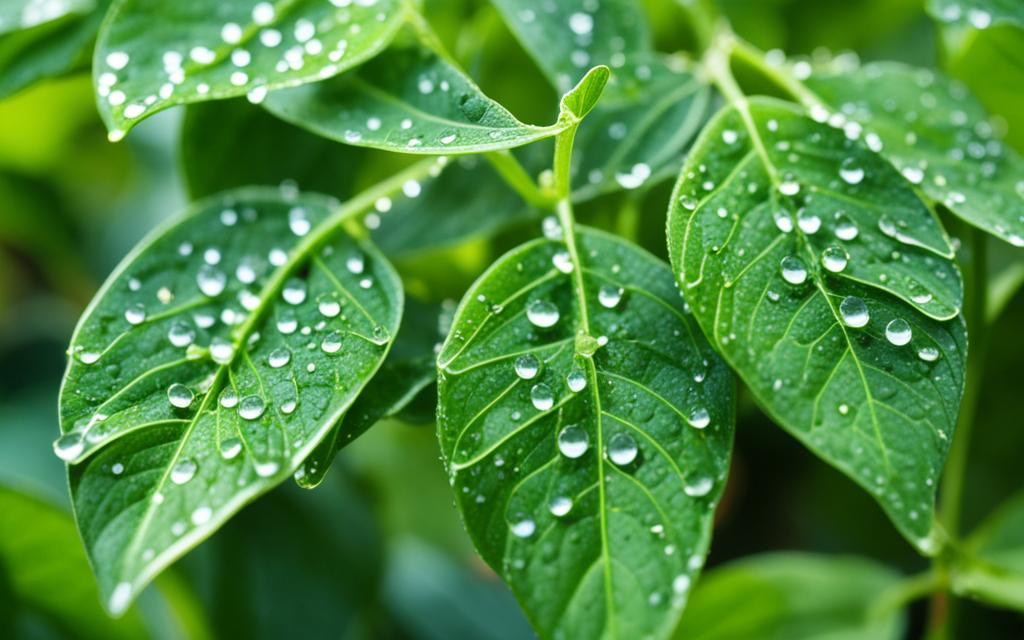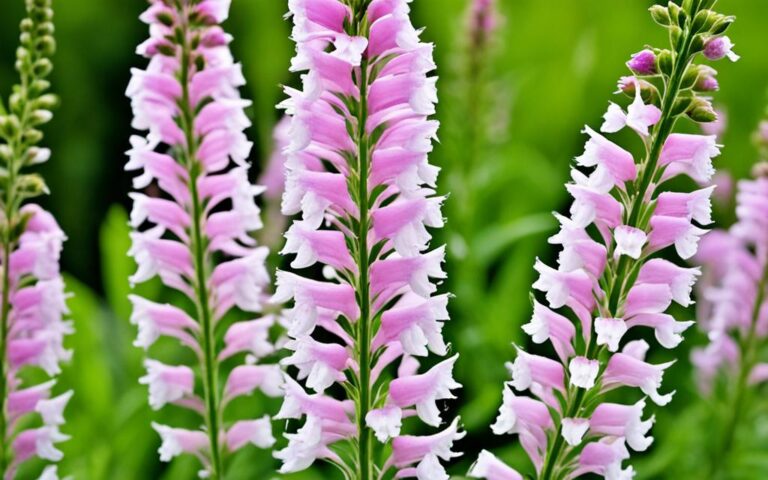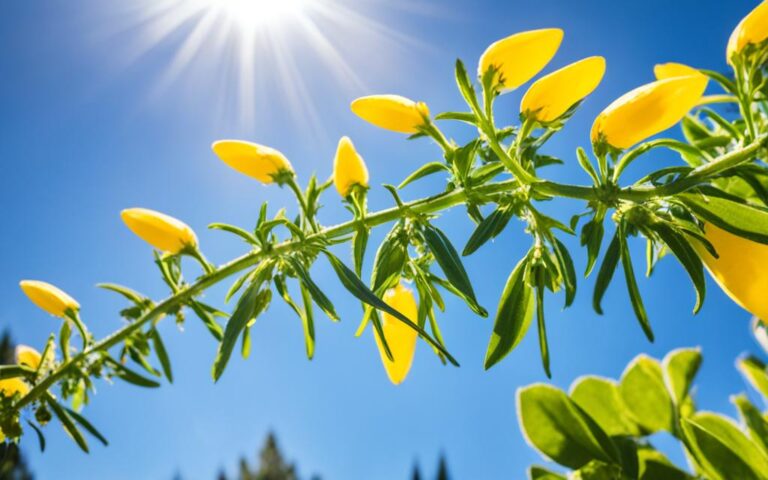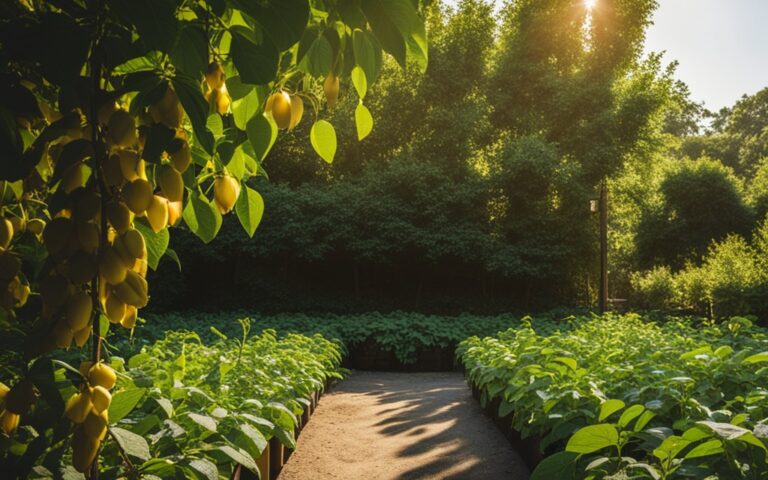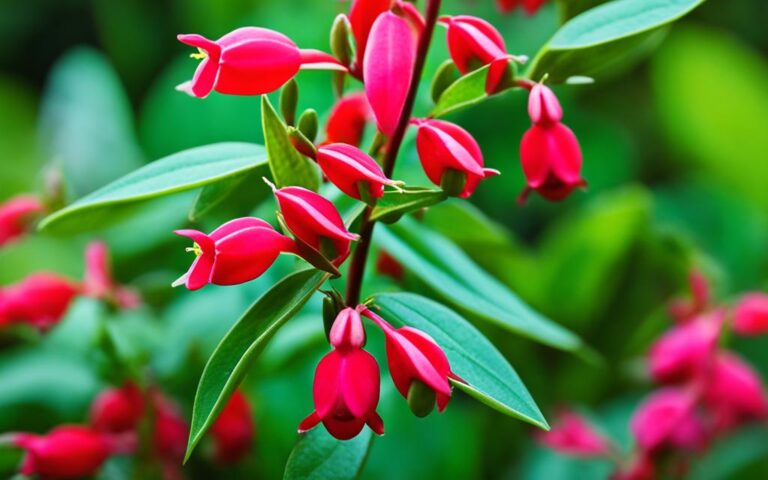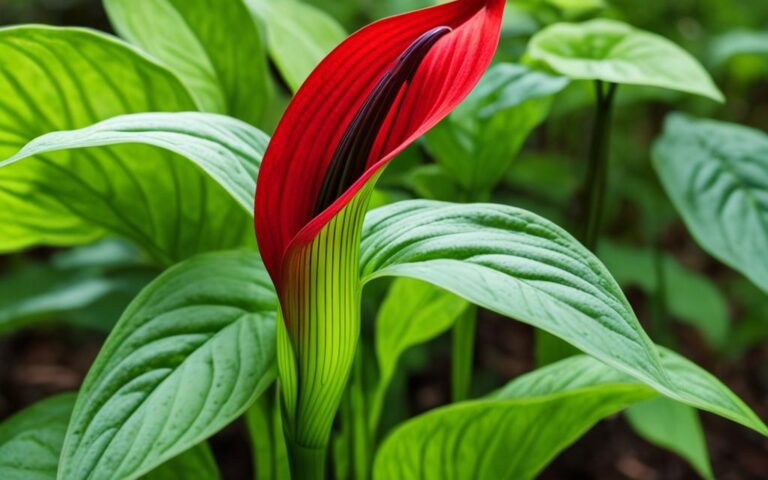Growing Black Pepper Plants: Tips for Success
Did you know a single black pepper plant can produce up to 12 pounds of peppercorns each year? This spice comes from the Piper nigrum vine and has been a key ingredient for centuries. If you love gardening, growing black pepper plants can be very rewarding. It gives you a steady supply of this tasty seasoning.
In this guide, we’ll share the best tips and techniques for growing black pepper plants. You’ll learn how to get a lot of flavorful peppercorns from your plants.
Key Takeaways
- Black pepper plants do best in tropical areas with temperatures between 75-85°F (24-29°C).
- They need well-draining soil and consistent water to grow well.
- You can start black pepper plants from seeds or cuttings for a good yield.
- It’s important to prune, fertilize, and manage pests to keep your black pepper plant healthy.
- Harvesting the peppercorns when they are fully ripe is crucial for the best flavor and quality.
Introduction to Black Pepper Cultivation
Black pepper, known as Piper nigrum, is a key spice loved worldwide. It comes from the Malabar Coast of India, where it’s been a big part of cooking for thousands of years. Its fame comes from its unique taste, versatility, and its long history as a sought-after trade item.
Importance and Popularity
People have always seen black pepper as a treasure, calling it “black gold” because of its high value. It’s a must-have in many kitchens, adding a sharp flavor to foods. The spice trade has played a big role in connecting cultures and shaping economies over the years.
Interesting Facts About Black Pepper
- The black pepper plant can grow up to 10 meters tall and produces small drupes.
- Ground black pepper has up to 3 percent essential oil, which gives it its unique smell.
- Pepper plants start producing fruit in 2 to 5 years and can keep going for up to 40 years.
- Whole peppercorns make black pepper when ground. White pepper is made by taking off the dark outer layer.
- Black pepper is the most traded spice, with Vietnam leading in production and export in 2020, making up 36% of global production.
Black pepper’s rich history and global importance have made it a staple in kitchens and a valuable crop. As we learn more about how it’s grown and used, we see its lasting impact on food and economies.
Common Varieties of Black Pepper Plants
The world of black pepper (Piper nigrum) is full of different types, each with its own taste and traits. The Malabar pepper and the Tellicherry pepper are two of the most well-known.
Malabar Pepper
Malabar pepper is the most common type of black pepper. It comes from the Malabar region of India. This pepper is known for its strong, rich taste. It’s a great all-purpose seasoning.
It’s also the most affordable among the piper nigrum varieties. This makes it a favorite for cooks all over the world.
Tellicherry Pepper
The Tellicherry pepper is a top-quality black pepper cultivar. It’s from the Tellicherry region of Kerala, India. This pepper is famous for its big, strong peppercorns and deep flavor.
It’s pricier than Malabar pepper but worth it for its quality. Chefs and food lovers look for it.
| Variety | Origin | Flavor Profile | Price Range |
|---|---|---|---|
| Malabar Pepper | Malabar region, India | Robust, rich | Lower |
| Tellicherry Pepper | Tellicherry region, Kerala, India | Complex, intense | Higher |
“The true connoisseur of black pepper will always seek out the premium Tellicherry variety, but the reliable Malabar pepper remains a staple in many kitchens.”
Understanding the Black Pepper Plant Anatomy
The black pepper plant, known as Piper nigrum, is a climbing vine that never stops growing. It’s part of the Piperaceae family. This plant is famous for its strong smell and taste that makes food flavorful.
Description of Leaves, Stems, and Flowers
The leaves of the black pepper plant are big and shaped like hearts, sometimes reaching 6 inches long. They cover and protect the peppercorns as they grow. The stems are thin but strong, letting the vine climb up to 30 feet high.
When the plant gets older, it produces small, white flowers in clusters. These flowers turn into the green, red, and black peppercorns we all know. They are the main product of the black pepper plant.
Special Features of the Black Pepper Plant
The black pepper plant can climb and stick to things like trees or trellises. This lets it grow up to 40 feet tall, getting lots of sunlight. This is perfect for its growth.
The plant’s big, heart-shaped leaves give shade and protection to the peppercorns. The thin, flexible stems help the vine wrap around its support structure.
“Black pepper is one of the most widely traded spices in the world, with India being a major producer and exporter.”
Ideal Growing Conditions for Black Pepper Plants
Black pepper plants, known as Piper nigrum, do best in certain conditions that match their tropical home. They need the right amount of light, temperature, humidity, soil, and water to grow well and produce lots of peppercorns.
Optimal Light Requirements
Black pepper plants like a mix of sun and shade. They need 6 to 8 hours of indirect sunlight each day. Direct sunlight can burn their leaves and harm the plant. If it’s cloudy, a sunlamp can help them get enough light to grow.
Temperature and Humidity Needs
Being from the tropics, black pepper plants love warm weather, between 75-85°F (24-29°C). If it gets colder than 60°F (16°C), they might not do well or could die. They also need high humidity, like in their natural home, to thrive.
Soil Requirements and pH Levels
These plants prefer soil that drains well and is full of nutrients, with a pH of 5.5 to 7. The soil should have a mix of organic matter, sand, silt, and loam for good drainage and nutrients. To check if the soil drains well, dig a hole and fill it with water. It should drain in 5 to 15 minutes, showing it’s good for the plants.
Watering Needs for Black Pepper Plants
Black pepper plants need regular watering to keep the soil moist but not too wet. In the growing season, water them 2 to 3 times a week. Make sure the soil is damp but not soaked. Let it dry a bit between waterings, but keep the roots moist. Use warm or room temperature water, as they don’t like cold water.
By giving black pepper plants the best conditions, gardeners and growers can help them produce lots of tasty peppercorns.
Propagating Black Pepper Plants
Growing your own black pepper plants (Piper nigrum) is rewarding and saves money. You can use seed and vegetative cuttings to propagate them. Choosing the right method is important for growing healthy black pepper plants.
Growing from Seed
Start by soaking black pepper seeds in water for 24 hours before planting. This makes the seeds easier to germinate. Then, plant them 1/4 inch deep in soil that drains well.
If you’re starting seeds indoors, keep the soil warm and moist until the plants grow. This can take 4 to 6 weeks.
Propagating from Cuttings
For faster results, use stem cuttings from healthy black pepper plants. The best time for cuttings is in spring or early summer. Plant the cuttings directly in the ground without soaking them first. Roots should grow within a few months.
Whether from seeds or cuttings, watering and air circulation are key for black pepper plants. Don’t overwater to prevent root rot. Add a little fertilizer once the plants are established.
“Propagating black pepper plants from cuttings is a great way to quickly grow new plants that are genetically identical to the parent.”
With proper care, your black pepper plants will flourish. They’ll give you a lot of flavorful peppercorns for many years.
Caring for and Maintaining Black Pepper Plants
Black pepper plants need a little care but are worth it. They can grow up to 15 feet long. So, it’s important to give them support like trellises or trees.
Pruning and Training Techniques
Pruning the stems and branches keeps the plant healthy and full of life. It also helps make new growth and peppercorn clusters. Training the vines to climb helps them get enough sunlight and air.
Common Pests and Diseases
Black pepper plants face pests like mealybugs and lace bugs. These pests can harm the leaves, stems, and peppercorns. Gardeners can fight them with safe insecticides or by using beneficial insects and neem oil.
Fertilizer Requirements
Black pepper plants do well with regular food, needing it every 2 weeks when they’re growing. You can use organic or synthetic fertilizers. Liquid or water-soluble ones work best for their shallow roots. Or, try compost or manure for a natural boost.
| Fertilizer Requirement | Recommendation |
|---|---|
| Nutrient Ratio | 7-9-5 (NPK) |
| Frequency | Every 2 weeks during growing season |
| Preferred Formulation | Liquid or water-soluble |
| Natural Option | Compost or well-rotted manure |
By using these tips for pruning, training, pest management, and fertilization, gardeners can keep their black pepper vines healthy and productive.
The black pepper plant Life Cycle
The black pepper plant, known as Piper nigrum, has a fascinating life cycle. It takes about 2 to 3 years to grow and start producing peppercorns. These peppercorns are loved by cooks all over the world.
In the first year, the plant builds a strong root system and grows its leaves. Then, in the second and third years, it changes a lot. It starts to flower and turns these flowers into green peppercorns.
As the peppercorns get ripe, they change color from green to a deep red. This is the best time to pick them. After drying and processing, they become the flavorful spice we all know.
The black pepper plant shows how tough and flexible it is. It faces many challenges but still produces a spice loved by people everywhere. Learning about its life cycle helps us understand and value this amazing plant more.
| Stage | Duration | Key Characteristics |
|---|---|---|
| Establishment | 1 year | Focus on root system and foliage growth |
| Flowering and Fruiting | 2-3 years | Development of small white flowers and green peppercorns |
| Peppercorn Ripening | Varies | Peppercorns transition from green to red, ready for harvest |
The black pepper plant’s life cycle shows its strength and ability to adapt. It overcomes many challenges to give us a spice we all love. Learning about its journey helps us appreciate this incredible plant more.
Harvesting and Processing Black Peppercorns
Harvesting black pepper at the right time is key to getting the best quality. The berries turn from green to a bright red when they’re ready. This happens several years after planting and can happen several times in the season. It’s important to pick only the ripe red berries and leave the green ones behind.
When to Harvest Black Peppercorns
The best time to pick black peppercorns is 6-8 months after the plant flowers. By then, the berries are fully ripe and have developed their unique taste and smell. Picking them at this stage is essential for the best quality and yield.
Drying and Processing Methods
After picking, dry and process the peppercorns. Lay them out in a single layer on a flat surface and let them dry in the sun for 7 to 9 days. They will turn black and shrink, showing they’re dry.
Once dry, store the peppercorns in a sealed container for up to 4 years. They’ll keep their flavor and strength. Drying them to 12% moisture content helps during transport but can make them lighter.
Processing black peppercorns includes fermentation, blanching, and drying. Fermentation turns the berries black, while blanching helps with drying and taste. After drying, store them in containers like polypropylene to keep their flavor and aroma.
“Tellicherry black pepper is the world’s most traded spice.”
Black peppercorns are a valuable spice, loved for their unique taste and health benefits. Knowing when to harvest and how to dry and process them ensures top quality and flavor for cooking and medicine.
Pest Management for Black Pepper Plants
Black pepper plants, known as Piper nigrum, face many pests that can harm their growth and yield. It’s key to know the common pests and how to control them for successful growing.
Common Pests and Their Identification
Mealybugs and lace bugs are two main pests of black pepper plants. Mealybugs are small, white, and round with many legs. Lace bugs have black bodies with horn-like parts. These pests harm leaves, stems, and peppercorns, causing stunted growth and discoloration.
Organic and Chemical Pest Control Options
To fight black pepper plant pests, gardeners can use organic and chemical methods. Organic ways include adding ladybugs or lacewings that eat the pests. Neem oil or insecticidal soaps can also deter pests. If pests don’t go away, non-toxic insecticides might be needed, but use them carefully.
Using a mix of cultural, biological, and chemical controls helps protect black pepper plants from pests. This keeps the plants healthy and productive.
“Providing ladybugs with a shelter, water source, and food supply enhances their presence in the garden, aiding in pest control.”
Extending the Growing Season for Black Pepper
Black pepper plants are often grown as perennials. But, gardeners in cooler climates might need to extend the growing season. One way to do this is by pruning the plant’s stems and flowers six weeks before the first frost. This helps the plant focus its energy on the peppercorns that are already there, making them mature faster.
Another method is to cut down the whole plant right before the first freeze. Then, hang it upside down in a dry place like a garage or basement. This lets the green peppercorns keep ripening, making the black pepper growing season longer.
- Starting seedlings indoors up to eight weeks before the last frost gives gardeners a head start.
- Raised beds, which are 4 inches or more above the ground, help with drainage and warming the soil faster. This means a longer growing season.
- Cold frames made from recycled materials let you grow plants in the cold, extending the planting season.
- Wall o’ Waters and cloches protect plants from frost, making the growing period longer through light frosts.
- Low tunnels and floating row covers shield plants from frost. They let growers start early in spring and protect in the fall.
Using these black pepper season extension techniques and protecting the black pepper plants helps gardeners get a bigger and longer harvest.
“Techniques to extend the growing season include soil-warming mulches and protective structures like tunnels and cold frames.”
Benefits of Growing Black Pepper Plants
Growing black pepper plants brings many benefits to gardeners. Black pepper is a key spice in many dishes, adding a unique, strong taste. It makes a wide variety of foods better, like meats, veggies, soups, and sauces.
Harvesting and grinding peppercorns yourself gives you a more intense flavor. This is better than using pre-ground pepper from stores.
Culinary Uses
Fresh black pepper from your garden can take your cooking to the next level. Its complex taste, with earthy and fruity notes, makes it a great spice for many dishes. It’s perfect for seasoning meats, sautéing veggies, or adding spice to sauces.
Having black pepper on hand can really change your cooking for the better.
Medicinal Properties
Black pepper is not just for cooking. It has been studied for its health benefits. The compound piperine in black pepper may help reduce inflammation and boost antioxidants. It can also help your body absorb nutrients better.
Black pepper is full of vitamins and minerals like vitamin K, vitamin C, and manganese. Adding it to your diet can be good for your health.
“The pungent flavor of black pepper is due to the presence of piperine, a compound that has been shown to possess a wide range of therapeutic properties, including anti-inflammatory, antioxidant, and digestive-enhancing effects.”
By growing your own black pepper plants, you get to enjoy fresh, flavorful spice. You also get to enjoy its health benefits. Whether you love cooking or want to use natural remedies, black pepper is a great choice for your garden.
Container Gardening with Black Pepper Plants
If you have limited outdoor space or want to grow pepper plants indoors, container gardening is a great option. Black pepper plants (Piper nigrum) do well in pots or planters. They can be trained up a trellis for the best growth. These plants need more water and food than those in the ground but can be very rewarding with proper care.
It takes a couple of years for black pepper plants to produce their first flowers and peppercorns. So, be patient. These plants love warm temperatures, making a sunny patio or conservatory perfect for them. Start by soaking the seeds for 24 hours before planting. They germinate best at 23.5 to 26.5°C (75-80°F).
Watering your pepper plants 2-3 times a week is key to their growth. Adding organic fertilizer every two weeks keeps them healthy. These plants flower all year, offering peppercorns in different stages of maturity from green to black to white.
| Cultivation Tip | Benefit |
|---|---|
| Soak seeds for 24 hours before planting | Aids germination |
| Maintain ideal temperature (23.5-26.5°C / 75-80°F) | Promotes optimal seed germination |
| Water 2-3 times per week | Supports healthy plant growth |
| Add organic fertilizer every 2 weeks | Maintains plant health and vigor |
With the right conditions and care, black pepper plants can flourish in containers. They offer a fresh, homegrown supply of peppercorns for cooking or for those who love pepper.
“Homegrown peppercorns require drying in the sun for a few days after harvesting before they are ready to use.”
Conclusion
Growing black pepper plants is rewarding for gardeners. It gives a steady supply of this versatile and flavorful spice. To make sure your plants grow well, you need warm temperatures, partial shade, and soil that drains well.
With the right care, like watering, fertilizing, and keeping pests away, black pepper plants can do great. They will give you lots of peppercorns that you can dry and use for years.
Black pepper plants are great whether you grow them in the ground or in pots. They look unique and are useful in cooking and medicine. With the right knowledge and effort, you can grow these plants and enjoy their tasty and aromatic peppercorns.
Starting to grow black pepper? Think about the best conditions, how to spread them out, and how to keep pests away. By doing this, you can make sure your plants stay healthy and keep producing. This way, you’ll have a garden that gives you plenty of this loved spice.
